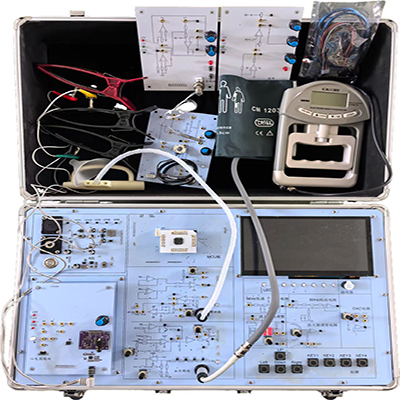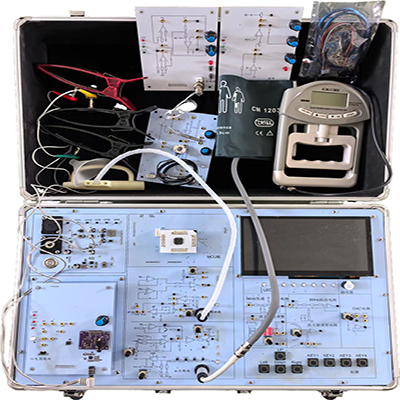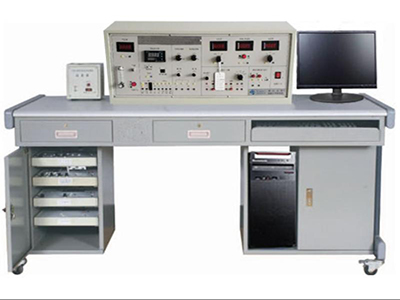The GL-SY-02 medical sensor experiment box is designed to meet the needs of medical colleges and universities. It combines the mainboard of the experiment box with various independent test modules to conduct measurement experiments. The circuit board layout of the medical sensor experiment box is reasonable and intuitive, with strong practicality. The modules are easy to use and organize, meeting the various experimental requirements of biomedical sensor measurement, medical microcomputer system design, medical signal analysis and image processing, etc. It can cultivate students' application capabilities in medical engineering fields such as electronic technology, signal detection and processing technology, and artificial intelligence technology.
GL-SY-02 medical sensor experiment box
The GL-SY-02 medical sensor experiment box combines the mainboard of the experiment box with various independent test modules in an orderly manner for measurement experiments in accordance with the use needs of medical colleges and universities. The layout of the circuit board of the medical sensor experiment box is reasonable and intuitive, and it is highly practical. The modules are easy to use and organize, meeting the various experimental requirements of biomedical sensor measurement, medical microcomputer system design, medical signal analysis and image processing, etc. It can cultivate students' application capabilities in medical engineering fields such as electronic technology, signal detection and processing technology, and artificial intelligence technology.
Ⅰ、Detailed configuration
(I) Pulmonary function module
Function: It can measure vital capacity, forced vital capacity, expiratory flow, etc.
1. Repeatability error: ≤0.1%;
2. Second-order 10Hz low-pass filter can be selected;
3. Measurement range: 0-10KPa;
4. Accuracy: 0.25%.
(II) Temperature module
Function: Equivalent to a monitor, which can monitor the patient's body temperature changes in real time
1. Constant current ensures its stability;
2. Optional second-order 10Hz low-pass filter;
3. The sensor is pluggable and prevents high-voltage transients;
4. Range 0-100°C Error:<2.5% Stabilization time: 30s.
(III) Blood oxygen module
Function: Equivalent to a medical oximeter, which can measure pulse rate and blood oxygen saturation
1. Adjustable magnification;
2. With second-order 10Hz low-pass filter;
3. The sensor is pluggable and prevents high-voltage transients;
4. 940nm wavelength infrared light/660nm wavelength red light, test range: 70%-100%
(IV) Pulse module
Function: Equivalent to a monitor, can measure pulse frequency, systolic pressure, diastolic pressure, etc.
1. The pre-stage signal is amplified 7 times, and the post-stage amplification is adjustable;
2. It has a second-order 10Hz low-pass filter;
3. It can prevent high-voltage transients;
4. Measurement range: 0-50g, accuracy level: 5%, repeatability error: ≤3%.
(V) ECG module
Function: Equivalent to an electrocardiograph, can measure heart rate, P wave amplitude, R wave amplitude, T wave amplitude, P-R time, QRS time, Q-T time, T wave time
1. 30 times pre-stage amplification, and the post-stage amplification is adjustable;
2. It has a second-order 10Hz low-pass filter.
(VI) Blood pressure module
Function: Measure blood pressure changes in the artery through waveform feature analysis
1. Pressure value 60-110mmHg; 90-190mmHg;
2. Accuracy: ≤3%.
(VII) Grip strength module
Function: Through human grip strength, rehabilitation training and finger strength test can be performed
1. Grip range: 300-500N;
2. Output: 0-5V, 0-10V, 4-20mA signal;
3. Elastic self-recovery.
Ⅱ、Experimental projects
(I) Physiological signal acquisition experimental projects
1. Pulmonary function experiment; signal acquisition, conditioning, computer or single-chip microcomputer for calculation and processing, and display results;
2. Temperature experiment; signal acquisition, conditioning, computer or single-chip microcomputer for calculation and processing, and display results;
3. Blood oxygen experiment; signal acquisition, conditioning, computer or single-chip microcomputer for calculation and processing, and display results;
4. Pulse wave velocity experiment; signal acquisition, conditioning, computer or single-chip microcomputer for calculation and processing, and display results;
5. ECG experiment; signal acquisition, conditioning, computer or single-chip microcomputer for calculation and processing, and display results;
6. Blood pressure Experiment; signal acquisition, computer or single-chip microcomputer for calculation and processing, and display of results;
7. Grip strength experiment; signal acquisition, conditioning, computer or single-chip microcomputer for calculation and processing, and display of results;
(II) Circuit experiment project
1. Adjustment and setting of operational amplifier gain;
2. Setting of low-pass filter and notch circuit cutoff frequency;
3. Square wave, sine wave, triangle wave generation circuit;
4. Zero adjustment circuit;
5. Programming and downloading to single-chip microcomputer:
1) I/O experiment;
2) LED control;
3) Buzzer control;
4) A/D conversion setting and control;
5) D/A conversion output control.
This medical sensor experiment box can be applied to basic medicine, clinical medicine, imaging medicine and other majors.

Synchronous PC version:
GL-SY-02 medical sensor experiment box https://www.biisun.com/home/category/detail/id/133.html


 Italian
Italian German
German Russian
Russian Turkish
Turkish Portuguese
Portuguese Spanish
Spanish French
French



